Damselflies hunt on the wing. They are not as acrobatic in flight as dragonflies, and I have seen them in flight manoeuvring slowly, rather like emaciated air balloons, floating horizontally searching for prey in the garden.
In the same taxonomic order (Odonata) as dragonflies, damselflies are categorised in a separate suborder. More slender and less robust than dragonflies, most damselflies fold their wings back above the abdomen when at rest.
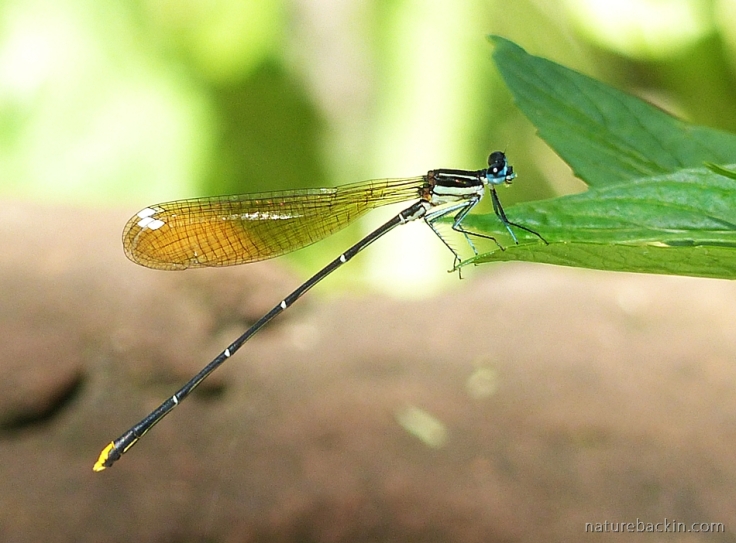
Resting on the end of a leaf, a damselfly in typical posture with the wings folded back
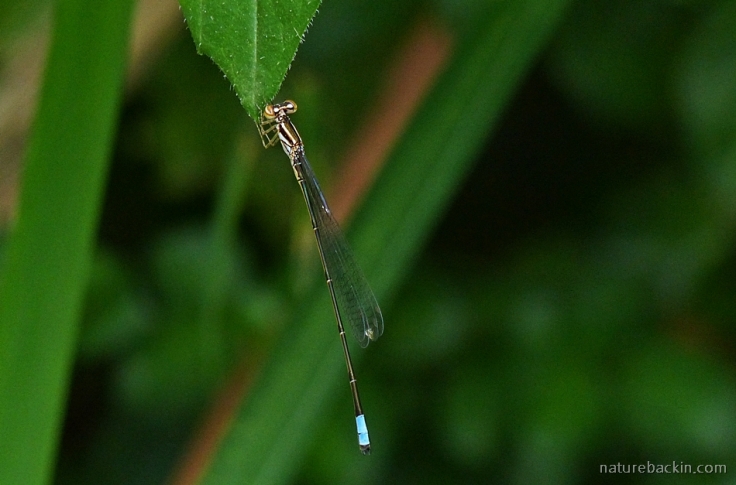
Another species of damselfly in the garden, taking a break from hunting and showing how slender and delicate it is. Like most damselflies when at rest, its wings are folded back vertically above and parallel to the abdomen
In keeping with their size, adult damselflies prey on small insects such as flies and mosquitoes. In flight, they grab their prey using their legs that are barbed with small spine-like hairs. Like dragonflies, damselflies have strong toothed jaws.

There are some species of damselflies that do not fold the wings back when perched such as this one pictured above
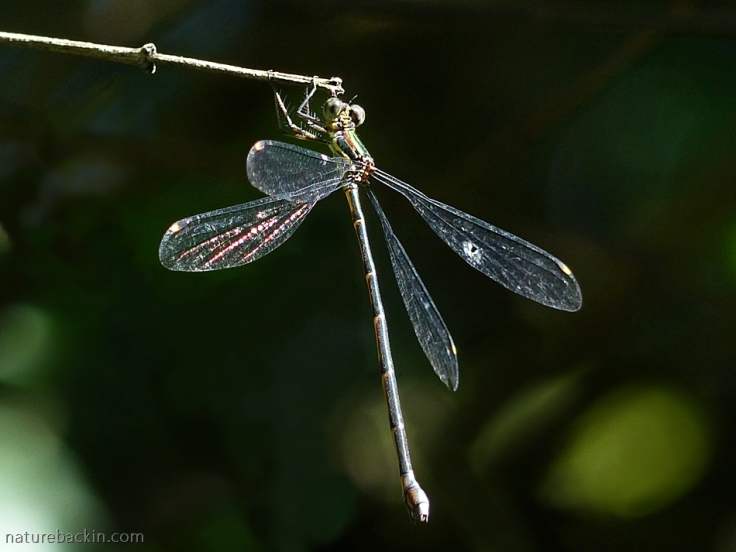
Even though this damselfly perches with its wings spread, it is still easy to see from its slender shape that it is a damselfly and not a dragonfly. Unlike dragonflies, in damselflies the eyes are distinctively separate on either side of the head

Generally, dragonflies are much more robust than damselflies, as in the photograph above
Adult damselflies, especially the females, may seek food away from water, but they are dependent on water for breeding. Most species of damselfly lay their eggs in water plants, especially in submerged plants. The carnivorous larvae that hatch from the eggs are entirely aquatic and they feed on other aquatic creatures. Damselfly larvae are equipped with gill-like appendages at the end of the abdomen that enable them to take oxygen from the water.
For its final moult, a damselfly larva climbs up out of the water and the adult emerges from the exoskeleton. Damselflies only have three forms in their lifecycle: egg, larva and adult. They do not pupate.
Damselflies have an unusual mating procedure. In preparation for mating the male removes sperm from the primary genital area at the end of the abdomen and transfers it to accessory genitalia further along the abdomen towards the thorax. In order to mate, the male clasps the female using a specialised appendage that fits into grooves behind the female’s head. Once so positioned the damselflies are now “in tandem” and they can fly together when so joined.
If receptive, once in tandem the female then curves her abdomen forward and upwards so as to be able to receive the sperm now located in the male’s subsidiary genital area that is at the second and third segments of his abdomen. This curved and complicated mating position is referred to as “the wheel”.
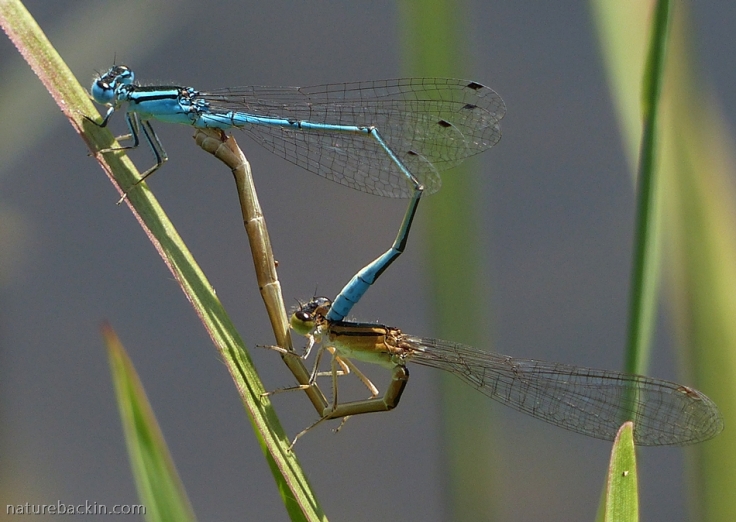
A pair of mating damselflies in “the wheel”. Depending on the species this coupling may last anything from a few seconds, to several minutes and even up to about an hour
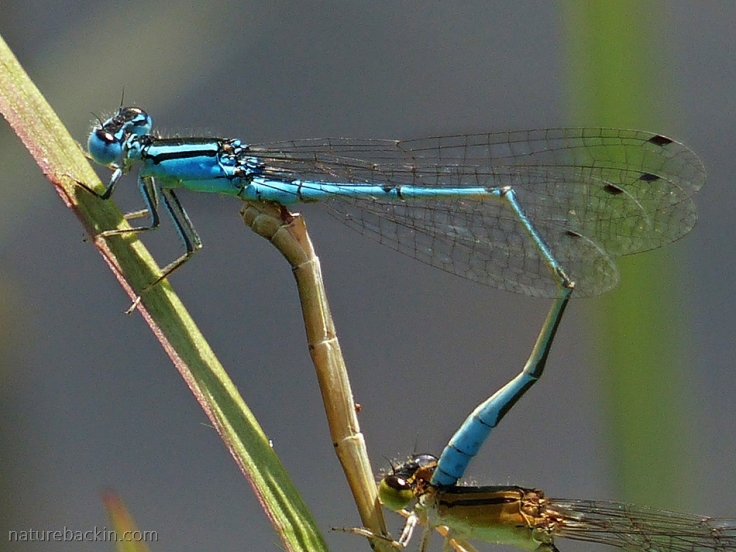
A close-up of the coupling structure in a mating pair of damselflies. In most damselfly species the male is more colourful than the female, who tends to be more camouflaged
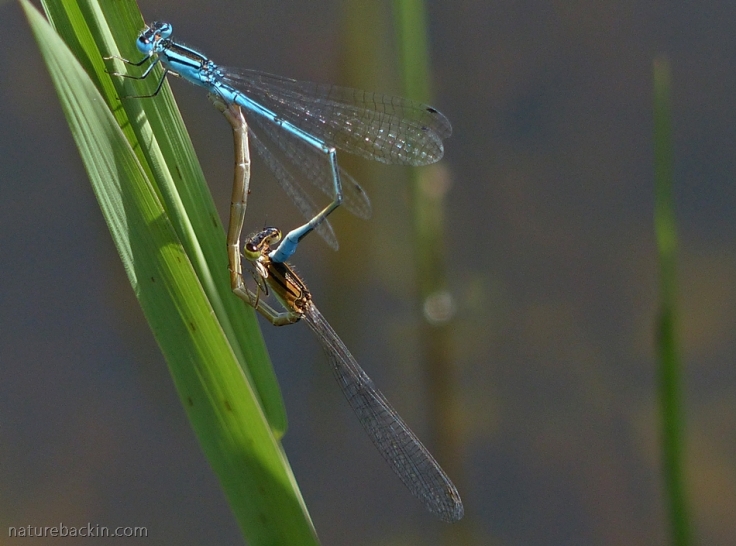
I photographed this mating pair at a dam in the KwaZulu-Natal Midlands. All the other photographs were taken in our garden

The damselflies in the photo above are in tandem, with the male still clasping the female behind the head. This pair has completed mating (unseen by me) and are preparing to lay their eggs in our garden pond. In this species the male has conspicuously red eyes and head

Another view of the pair in tandem. The female is perching and the male is balanced above her. (I have not attempted to identify any of the species of damselfly in these photographs – I think that requires more specialist skills than I have!)

Still in tandem, the female is starting to oviposit, lay her eggs, below the surface of the water. The tip of her abdomen is submerged as she starts to lay
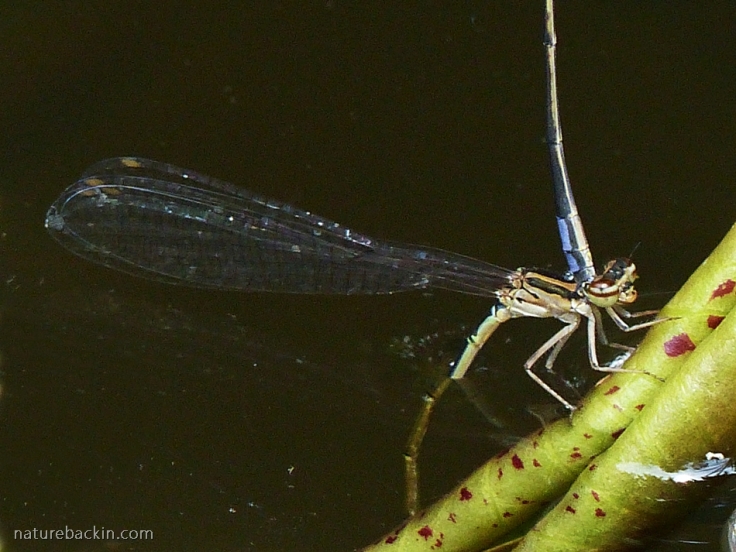
Above is a close-up of the female as she starts to lay her eggs in a curled up leaf of a waterlily

As the egg laying progressed the female submerged entirely. Adult damselflies can breathe underwater as they are encased in a small bubble of air. The pair is still in tandem, and the male is still above the surface of the water
Not all species of damselfly remain in tandem when the female starts to lay her eggs. It is thought that the benefit of the male remaining with the laying female is to protect her as she lays the eggs. And not all species of damselfly that remain in tandem submerge as completely as this pair does. It seems to be risky behaviour as both damselflies are at risk of predation from fish and other creatures, and it is not understood why in some species the pair submerges completely like this. They can stay submerged for as long as 20 minutes.

In this photograph it is possible to see the pair are completely submerged, and the male continues to clasp the head of the female as she lays her eggs in submerged vegetation
I did manage to film a short sequence as the damselflies started to submerge. Unfortunately, I was so surprised that I stopped filming to see what was going on! The female started to submerge so rapidly I thought that she had been grabbed by a predator, but it turned out that was propelling herself deeper under the water, dragging the male down with her. I lost sight of them in the vegetation, but I can only assume that they surfaced once egg laying was completed. Fortunately for them, we no longer have fish in the pond.
Despite its abrupt end, I include the short video clip of the submerging damselflies. The clip is introduced by footage of the pond cascade, and it is followed by another clip showing tadpoles in the pond.
Sources: Learn About Nature. Dragonfly-site.com https://www.dragonfly-site.com/damselfly.html (https://www.learnaboutnature.com/); Samways, Michael J. 2008. Dragonflies and Damselflies of South Africa. Sofia-Moscow: Pensoft.

Posted by Carol









May 23, 2019 at 8:58 pm
Again such beautiful photography! And another of my favourite subjects.
LikeLiked by 1 person
May 24, 2019 at 3:38 pm
Thanks so much. Glad to know you also enjoy damselflies.
LikeLiked by 1 person
May 22, 2019 at 9:14 am
I am absolutely baffled by your photography and have learned so much today because of this article. Thanks Carol!
LikeLiked by 1 person
May 22, 2019 at 9:26 pm
Thanks so much Suzette. The chance to photograph those damselflies lead to me learning more about them too, so it was nice to share what I learned.
LikeLike
May 20, 2019 at 11:18 pm
Wonderful post, very informative as well as a treat for the eyes. This is a favorite subject of mine and I know how difficult it can be to capture the beautiful detail that you did so well.
LikeLiked by 1 person
May 21, 2019 at 8:31 pm
Thank you very much Nick. These tiny insects are a challenge to photograph, but it does help that they so often remain in the same place or are slow moving, and that they are out and about when there is decent light.
LikeLike
May 18, 2019 at 7:13 pm
Simply stunning! I agree with Margaret; I love the soundtrack as much as the images. I’m always astounded at the complex variety when it comes to reproduction. I had no idea about these processes for damselflies. You must have great patience, Carol, as well as a very good eye, in order to capture these pictures.
LikeLiked by 1 person
May 21, 2019 at 8:25 pm
Thanks very much Sandra. I find it really engrossing watching all these little creatures and the hard part is not to get distracted. In fact it was when watching damselflies that I got distracted by a fishing spider, which became the subject of a previous post. One thing can lead so unexpectedly onto another!
LikeLiked by 1 person
May 18, 2019 at 11:18 am
Fantastic shots and post, Carol! Thank you for all interesting information!
LikeLiked by 1 person
May 21, 2019 at 8:18 pm
Thanks very much Leya. They certainly are interesting creatures.
LikeLiked by 1 person
May 18, 2019 at 5:58 am
It’s lovely to read about creatures we have here too – presumably not quite the same varieties. Wonderful documentation, and I loved the soundtrack in your video as much as the film!
LikeLiked by 1 person
May 21, 2019 at 8:01 pm
Thanks Margaret. Nice to think that varieties of the humble damselfly occur across the globe. I listened to the sound on the video again, and amid the water sounds I heard a Drongo calling during the damselfly sequence.
LikeLiked by 2 people
May 17, 2019 at 7:55 am
Brilliant article love all the pics.
So interesting. Thanks for sharing ❤️
LikeLiked by 1 person
May 17, 2019 at 6:37 pm
Thanks Debs. Glad that you liked it and found it interesting too ❤️
LikeLike
May 17, 2019 at 7:46 am
Superb documentation! It’s every time a delight observing damselflies.
LikeLiked by 1 person
May 17, 2019 at 6:35 pm
Thank you Simone. Yes they are delightful to see.
LikeLiked by 1 person
May 17, 2019 at 7:37 am
They are fascinating creatures and your patience and good observation has benefited us all.
LikeLiked by 1 person
May 17, 2019 at 6:28 pm
Thanks Anne. I don’t see them around all the time, but maybe I am just more observant at some times than at others. They certainly are fascinating.
LikeLike
May 17, 2019 at 6:18 am
What great photos. I’m wildly jealous. How nice to have that kind of activity in your garden.
LikeLiked by 1 person
May 17, 2019 at 6:27 pm
Thanks Graham. We are lucky to have a garden in an area that supports a fair amount of wildlife so there is always lots going on.
LikeLiked by 1 person
May 17, 2019 at 2:10 am
Wow Carol, what a fascinating look into the lives of these beautiful insects – Thank you so much!
(And I am a little jealous that you have them frequenting your garden)
LikeLiked by 1 person
May 17, 2019 at 6:24 pm
Thanks very much. I also found them unexpectedly fascinating. I am not sure why they are here, but should think that the pond and also some dense and relatively undisturbed vegetation has something to do with it, as well as being on the edge of town. Or else its the mosquitoes that attract them 🙂
LikeLiked by 1 person
May 17, 2019 at 1:25 am
Fantastic captures, Carol…..and as always, I learned a lot!
LikeLiked by 1 person
May 17, 2019 at 6:21 pm
Thanks very much Sandy. I also learned a lot from watching and then reading about these tiny creatures.
LikeLiked by 1 person
May 17, 2019 at 1:01 am
So fascinating, I had no idea that they went under water like that. Superb observations, Carol!
LikeLiked by 1 person
May 17, 2019 at 6:19 pm
Thanks Eliza. As I mentioned, I got quite a shock when for the first time I saw them submerge so completely! Seems they are quite robust even though they look so delicate.
LikeLiked by 1 person
May 16, 2019 at 9:12 pm
Literally breathtaking photos and explanations. I used to see them at the previous yard quite often, but not so much here at the new location. Can’t help but wonder what it is they’re missing here. Thanks so very much for another marvelous informative post.
LikeLiked by 1 person
May 17, 2019 at 6:16 pm
Thank you Gunta. I wonder why we have them here actually. Did you have permanent water at or nearby your previous place but not so much now?
LikeLike
May 18, 2019 at 4:08 am
This seems to have put the brain in motion, comparing the differences from the point of view of a damselfly…
Very nearly the opposite as far as the amount of water, but at the previous house there was a small fish pond with big leafy plants hanging down to the water very near the back door . Here… we have lots of water in the winter… rain and a raging creek which fades to a small trickle come summer. I suspect it’s more the plant life or other conditions that make the difference. Perhaps? Or the creek is farther away and not as convenient for me to visit more often.
LikeLiked by 1 person
May 21, 2019 at 6:55 pm
It is interesting to think about what makes the difference. I gather that different species of damselflies have different needs, but many need standing water with adequate vegetation for breeding, although there are some specialists adapted to very particular circumstances. Maybe for some species a garden pond with suitable aquatic plants, as you say, is more hospitable than a creek?
LikeLike